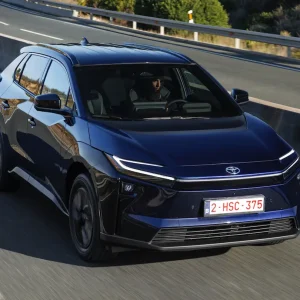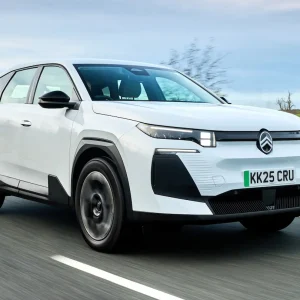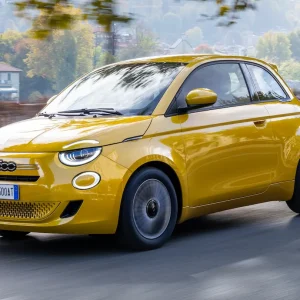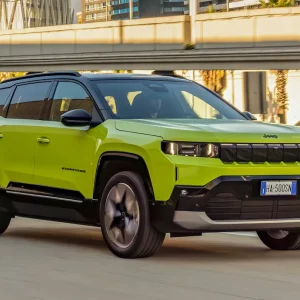Final Report: (Not) ice cold in Astra
Running a car for an extended long-term test of course allows us to give a wider-ranging assessment than those afforded from our regular reviews. There has just been a clear demonstration of this with our Astra, whereby having had the car for six months, it took until the very last week of the test for an opportunity to assess its cold weather capabilities to arise.
Having emerged from my house on a -3C morning to find the Astra fairly thoroughly iced in, I naturally engaged the heated windscreen, and the results were very impressive, with the screen being completely clear and ready for driving in mere moments. Once on the move, the heated steering wheel was good too, providing a subtle yet very welcome warming touch. Our car also comes with heated front seats, but actually, the main climate control system proved so effective at heating the cabin, I didn’t feel the need to engage this.
It all makes for a strong note on which to end our time with the Astra, which I have found generally impressive. It looks good (with the exception, in my view, of the Electric Yellow paint), drives well, and features an impressive infotainment system with a good mix of physical and touchscreen controls (an occasion I mentioned in a previous report where my phone failed to connect wasn’t repeated, with an instance of the useful head-up display not appearing for a journey also proving isolated). As usual, since my test cars tend to spend lots of time on motorways, I appreciated the provision of an automatic gearbox and adaptive cruise control – though as also reported previously, I did have to step in sharply on one occasion when approaching a traffic jam with the latter system engaged.

As I’ve noted before, with no home charger I very rarely plug in test cars, so I’m far from the best person to get peak efficiency from a plug-in hybrid. Bearing this in mind, a test average figure for the Astra of 47mpg is pretty good.
Certainly, I expect that figure is better than I would achieve with an equivalent SUV, which brings us back to the central question of this test, of whether the Astra (now two-time winner of Business Car’s Best Family Car award) can prove hatchbacks still pose a viable alternative to SUVs. Admittedly, I don’t have a family to transport, but from my point of view I would say absolutely – the gap in terms of boot and interior space is really pretty minimal, and as well as being more efficient, a lower-to-the-ground car will also tend to be better to drive, and cheaper. Although, that final point does bring me to another issue the Astra could never quite overcome – as good as it may be, and well equipped as it is in the Ultimate spec we tested, people were always unpleasantly surprised when I told them I was driving a Vauxhall Astra that cost £42,000. Hopefully, this just reflects a bad image hangover from Vauxhall’s days under General Motors ownership, and with the Stellantis-era brand continuing to release new impressive models this tide can be turned. Here’s hoping so, anyway, or my next test car might face even bigger problems – of which more shortly.
5th Report: Space race
When considering advantages of a trendy SUV compared with the traditional family hatch, an obvious suggestion might be luggage capacity. So, can our Astra uphold its honour in this regard?
Well, with our car you get 352 litres of boot space, which sounds nothing more than okay, but it is actually bigger than those offered by plug-in hybrid hatch alternatives such as the Volkswagen Golf and Cupra Leon (although slightly down on the Astra’s Stellantis group cousin, the Peugeot 308). Plug-in hybrids generally tend to be hurt in this area by the presence of the necessary large battery under the boot floor, and our car is no exception – petrol and diesel Astras get an extra 70 litres of space. As for the SUV comparison, PHEV versions of Vauxhall’s Grandland come with 390 litres, so again on that basis our Astra doesn’t fare too badly – 38 litres is hardly a game-changing amount of difference.

Speaking of the PHEV powertrain, unlike with some plug-in cars, our Astra doesn’t come with under-floor storage for the charging cable, however it does get a neat storage case with magnetic lid, which I do like, since although it obviously takes up a little of the main boot space, at least there is no untidy tangle of cable spreading out and getting in the way all the time.
If you need more room, the Astra’s seats fold in a fairly standard 60/40 manner, although there are no remote levers to fold them from the tailgate (the Sports Tourer estate version does get these, along with 40/20/40 seat folding). However, our car does come with a load-through ski hatch behind the centre seat armrest (standard on mid-range GS-spec cars and above), which means long yet narrow items can be accommodated along with two rear-seat passengers. On the subject of those back seats, they offer occupants a decent amount of legroom, and a good amount of headroom – the latter despite a panoramic sunroof being standard with our Ultimate-spec test car.
Returning to the hatch versus SUV debate, a potential advantage of the hatch is providing a more dynamic drive. This is something the Astra is good at – it might not be quite as sharp as the best handlers in the class, such as the Ford Focus and Mazda 3, but it’s not far off. Vauxhall does provide ways to augment this further via its selectable drive modes. Choosing ‘sport’ mode allows more EV power go to assisting the engine and improving performance – although this is dependent on charge level – and adds weight to the steering. In practice, though, this isn’t something I’ve tended to bother with. The acceleration available in the default ‘hybrid’ mode is still more than adequate – in fact passengers have commented on the level of torque available during normal driving – and the regular steering is also fine. The same sort of thing applies to the gear shift paddles – although they are fairly responsive, bothering with them rather than just leaving the automatic gearbox to do its thing never really feels worth it, especially given that there is no traditional rev counter display to work with.
4th Report: Screen time
Sometimes it’s easy to lose sight as a motoring journalist of just how fast the car industry’s pace of technological development can be. For example, just two years ago I ran a Ford Puma as my long-term test car for a few months. At the time, I had no issues at all with its 8in infotainment touchscreen. However, on getting into another Puma last month, it now seemed small and a bit out of date, and also struck me as being inconveniently angled – straight ahead, rather than towards the driver.
The Ford’s screen has been made to look second-rate by the proliferation of larger screens like the one fitted to our Astra. This boasts a 10in touchscreen, which sits alongside a digital driver display of the same dimensions (our Ultimate-spec car also features a head-up display – the 10in screens are standard throughout the range).
As well as its large size, the touchscreen is nicely angled towards the driver, creating a neat wraparound effect when combined with the driver display that gives a sense of being in a cockpit.
The touchscreen itself features sharp graphics and responds well to touches. In an aid to usability, two rows of physical buttons below the screen include ventilation controls and system shortcut buttons, while a stereo volume knob also features.
There’s also a useful space between the two rows of buttons on which a hand can be braced, making the touchscreen easier to operate on the move.

However, the set-up isn’t without fault, with my chief annoyance concerning Apple Carplay. This runs off my iPhone wirelessly, after I selected this option when the car arrived rather than the wired alternative, hoping it would prove to be more convenient.
In fact it’s proved the opposite – sometimes it will connect immediately without issue, however other times there will be a delay, and on one occasion recently it failed to connect at all, despite my turning everything off and on again including the car itself, meaning I had to go without for a 90-minute drive.
On the plus side, this did give me occasion to try out the Astra’s own TomTom-based sat-nav, which I hadn’t before, and this proved adequate. However, it also meant I was stuck listening to the radio rather than my usual music and podcasts.
Of course, this is not the end of the world, but still annoying, and an occurrence I’m hoping isn’t repeated, especially on the long many motorway jaunts that I often undertake.
Carplay isn’t the only inconsistent wireless feature either – the associated wireless charging pad often drops in and out several times during a journey, needing my phone to be nudged from side to side before it will apparently re-find it and resume charging.
Given I’m not watching the charging status symbol the whole time when I’m driving, it means it is rare that I end a journey with a fully charged phone to rely on – something that would certainly be a given if I was instead using the wired connection. On that front there is decent provision at least – with two USB ports in the front of the car, and a further one in the rear, which would likely be appreciated by those with families.
3rd Report: Brake point
Adaptive cruise control is one of several driver assistance technologies that have become increasingly prevalent on new cars over the past few years. For those not familiar, the systems allow a car to follow the vehicle in front at a set distance, speeding up when it speeds up (to a set limit), and slowing down when it slows down, even to a complete stop in some cases (usually on cars with automatic gearboxes) before moving off again. Generally best suited to motorway journeys, especially those in stop-start traffic, they can divide opinion, but personally I’m generally a big fan of their stress-saving qualities. However, systems fitted by different manufacturers can have varying degrees of competence, and although the one installed with our Astra has been fine for the most part, I do have one lapse to report.
Travelling down a dual carriageway at 70mph one day, with the system engaged, a line of red brake lights suddenly appeared up ahead, indicating an approaching traffic jam. As expected, the Astra started to slow in response, but fairly gently, so I covered the brake pedal ‘just in case’, while still thinking from experience that I wouldn’t need to intervene and we would soon pull up. On this occasion, however, I was mistaken, as with the back of the car in front still approaching fairly quickly the system unexpectedly gave up on me, and a ‘take control’ message flashed up on the dashboard. Fortunately, I was ready to react, but some fairly stiff braking was still required, with the Astra squirming about a bit as I brought it to a halt.

Anyway, as it turned out, no harm done – but a warning to those who might be tempted to allow their minds to wander when using such systems, and a slightly alarming experience at the time. Also, it’s not something I’ve had happen with the systems in any other test cars.
On reviewing the Astra’s instruction manual, it does explain that the system’s automatic braking force ‘does not permit hard braking’ and warns the braking level ‘may not be sufficient to avoid a collision’, advising that the system be deactivated in situations such as ‘when the vehicle ahead sharply decelerates’. So, on that basis we can assume the system was working as designed. I would, however, counter that a) this is not what I would have expected given that such situations are hardly uncommon on motorways and b) it seems strange that a vehicle with autonomous emergency braking also fitted is unable to slam the anchors on in this circumstance. Having subsequently looked up AEB in the manual, it explains that while a radar-equipped car such as our Astra can deploy this system at up to 87mph when a moving vehicle is detected, for a stationary vehicle (or pedestrian or cyclist) this limit is reduced to 50mph. In other words, come across stationary traffic at motorway cruising speed and you’re on your own. I’m sure, therefore, that if anything had gone wrong in my incident, Vauxhall would have argued that its technology functioned as designed – but I wonder how many other drivers would have wrongly assumed, like I did, that it would cover for them in that situation?
2nd Report: Low rider
When we take cars for long-term review on Business Car, the idea is that we can, over a period of several months, gain a deeper understanding of the car’s strengths and weaknesses in day-to-day life than would be possible in a shorter test. However, in the case of our Astra, I’m tempted to skip straight to the end, and answer the question I first posed last month, of whether it could stand up for hatchback-kind against SUVs, with a resounding yes.
Much of this is in the context of the Citroen C5 Aircross, the fellow Stellantis plug-in hybrid model I ran before the Astra. Although, owing to my lack of home charging facilities, I’m yet to plug the Astra in, I’m still averaging more than 47mpg with it in my early running, which compares with the less than 39mpg averaged by the Citroen in my time with it. This is a welcome advantage for the Vauxhall, not just from a cost point of view, but also convenience, since I’m covering at least 50 miles further between fill-ups.
Also, the Vauxhall’s lower weight and centre of gravity (and different chassis priorities from the Stellantis brands’ respective engineering teams) mean a far more dynamic drive. Okay, the Citroen is still more comfortable, but the Vauxhall’s ride is absolutely fine nevertheless, with no feelings of regret from myself so far on long motorway trips. In addition, although opinions I realise will differ on this, I personally much prefer to be sitting lower down, rather than raised up in the usual SUV manner.

Negative points for the Astra? Well, the Citroen is wider, which will probably appeal to those who regularly carry three people in the back, and it does have a bigger boot. Also, perhaps surprisingly, the Astra is £4,000 more expensive as tested, which although we are talking mid-range (albeit more powerful) Citroen versus top-spec Vauxhall does bring me on to a wider point, which is that impressive though the current model may be, the reactions of people when I tell them the sticker price has shown that the idea of paying more than £40k for a Vauxhall Astra can still be a pretty difficult one to swallow for some.
Something else negative I have to report concerns the Astra’s head-up display. This does a great job of putting info such as speed and sat-nav instructions – including from smartphone-based systems – in the driver’s eyeline, however on one recent trip it failed to appear. Not the end of the world, as if this happens the info appears on the regular digital instrument cluster, and it has resumed working since, but I’ll be keeping an eye out for any repeats, since anyone paying the aforementioned price for a car with technology such as this will want to be able to reliably benefit from it. Worth noting also, for any reading Blues Brothers or similar – the head-up display is very difficult to read when wearing sunglasses.
One last word for now, concerning our Astra’s Electric Yellow metallic paint. I reported last time that the shade had divided opinion, but having driven it around for a few more weeks and received other views, it appears the consensus is very much in the negative. However, I should note one thing in its favour – it does make the Astra easy to spot in car parks.
1st Report: Add Astra
Something interesting happened to me in Germany last year at the launch of the Vauxhall Astra Sports Tourer estate. For the first time in my career as a motoring journalist, I found myself driving a Vauxhall I actively liked.
Don’t get me wrong, I’ve driven some decent cars from the brand, such as the latest electric iterations of the Corsa and Mokka. But this was the first time I was behind the wheel of a Vauxhall that I might have considered if I’d been in the market for such a car with my own money.
Therefore, I was pleased to discover that an Astra – albeit a hatch rather than a Sports Tourer – would be my latest long-term test car. In addition, it’s a plug-in hybrid, which is also good news, as on the aforementioned German launch I preferred this powertrain to the pure petrol alternative. It is a second Stellantis group plug-in hybrid in quick succession for me following the Citroën C5 Aircross SUV I had earlier this year, but with the Vauxhall having a lower overall power output (though at 180hp it’s still hardly underpowered) and a less bulky frame, I’m expecting to see better efficiency from it.
Incidentally, that brings me on to another reason for excitement – that this is my first non-SUV long-termer for a couple of years, which as someone who values driving dynamics over practicality is also welcome.
All this positivity towards my new car was, however, somewhat disrupted when I saw the colour. Vauxhall calls it Electric Yellow, but personally I think the hint of green brings rather a snotty appearance that’s unfortunate to say the least. Although, in fairness, I should also note that when I pulled up to my house in it for the first time, my next-door neighbour, who happened to be sitting in her front garden, commented on how much she liked it – so clearly, as you might expect, opinions on this are subjective.
Our Astra is in the range-topping (except for the more powerful GSe variant) Ultimate equipment grade, with the only options fitted the aforementioned paint, and a 7kW on-board charger. Standard features of this spec include a head-up display, which, unlike the one on the Citroen E-C4 X I sampled last month, doesn’t need to theatrically rise from the dashboard each time, and is the better for it – and adaptive LED pixel headlights, which have impressed me on my initial night drives with their ability to illuminate only the bits of the road ahead with no one to dazzle. There’s also a panoramic sunroof, which isn’t normally a feature I’m in favour of, but might help to counter the effects of a black roof on a car that arrived just before a heatwave. At least on this front, the Alcantara seat trim we have is probably a better option than the leather alternative.
Ultimate spec also comes a wide range of driver assistance tech, including semi-autonomous lane changing, which I’m looking forward to trying out on my regular motorway journeys. Normally, it’s those environments where my long-termers tend to sink or swim – and with the Citroëns’ comfort-focused approach having paid dividends there, I’m hoping the Astra’s greater dynamic potential doesn’t prove to be at the expense of ride quality, and therefore my disposition at the end of a long drive.
Standard equipment:
Adaptive LED pixel headlights with high beam assist, LED front fog lights, LED tail lights and DRLs, 18in diamond-cut alloy wheels, dark-tinted rear windows, black roof, alloy-effect pedals, dual-zone climate control with air quality sensor, keyless entry and start, heated steering wheel, heated windscreen, heated front seats, automatic wipers, Alcantara seat trim, electrically heated and folding door
mirrors, load-through rear-seat armrest, panoramic sunroof, 10in touchscreen, wireless Apple Carplay and Android Auto connectivity, 10in digital instrument cluster, head-up display, wireless smartphone charger, 360° parking camera, front and rear parking sensors, adaptive cruise control, lane departure warning with lane keep assist, lane change assist with side blind spot alert, lane positioning assist, rear cross traffic alert, automatic emergency braking with pedestrian detection, traffic sign recognition, driver drowsiness alert.
Options:
Two-coat premium metallic paint (£700)
7.4kW single phase on-board charger (£500)





